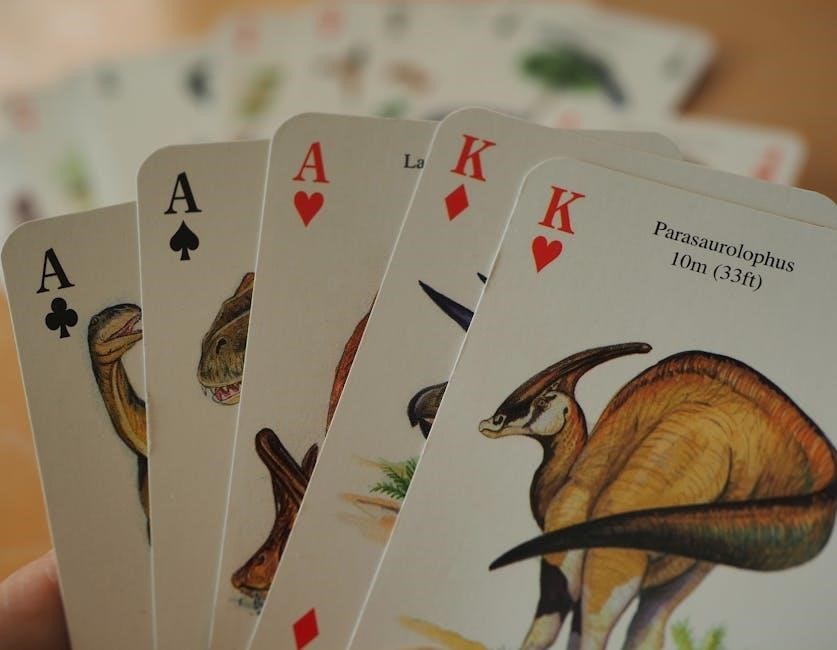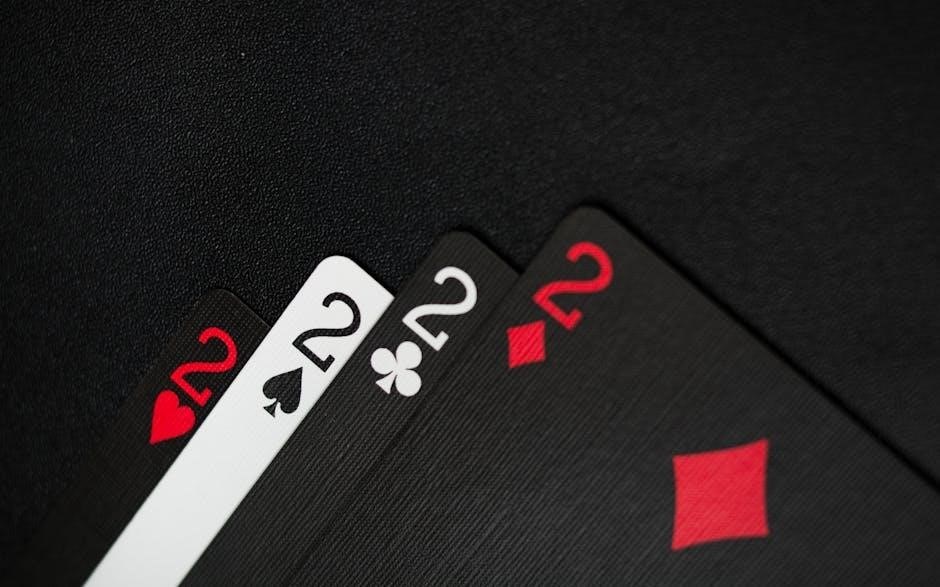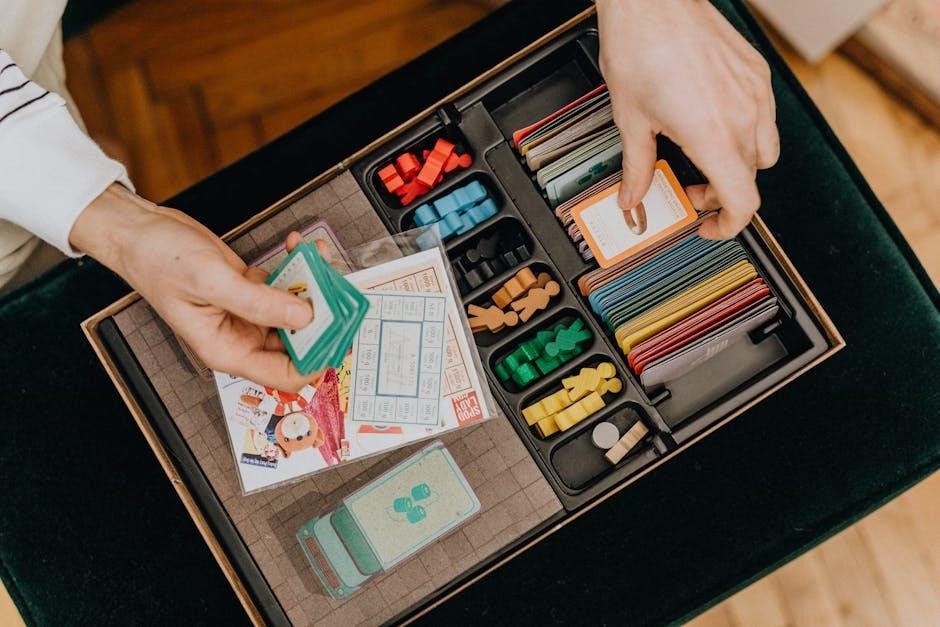Discover how a simple deck of cards can transform math practice into an engaging, interactive experience. These games foster number recognition, mental math, and strategic thinking while making learning fun and accessible for all skill levels.
Overview of Math Games Using Playing Cards
Playing cards offer a versatile tool for engaging math practice, catering to various skill levels and operations. From addition and subtraction to multiplication and division, these games provide interactive ways to reinforce math facts. Suitable for individuals or groups, they often involve strategic thinking and problem-solving. Many games adapt to different ages by adjusting card values or complexity, ensuring accessibility for younger learners and challenge for advanced players. The simplicity of a deck makes these activities easy to set up and enjoy, fostering a fun, hands-on approach to math education.
Why Playing Cards Are Effective for Math Learning
Playing cards are a powerful tool for math learning due to their versatility and hands-on nature. They provide a tangible way to engage with numbers, making abstract concepts more concrete. The use of cards encourages active participation, fostering number recognition and mental math skills. Games can be easily adapted to different skill levels, ensuring that learners of all ages can benefit. Additionally, the competitive aspect of many card games motivates students to practice and improve their math abilities in a fun and interactive environment, enhancing both understanding and retention of math concepts.

Materials and Setup
A standard deck of 52 playing cards is essential, with face cards often removed. For younger students, one deck suffices, while older students may use two decks combined for enhanced challenge and variety in gameplay.
Deck Requirements and Modifications
A standard deck of 52 playing cards is typically required, though modifications are common. Face cards are often removed to simplify games, while aces are usually valued at 1. For younger students, one deck is sufficient, but older students may use two decks combined, excluding aces, 2s, 10s, and face cards to create a 56-card deck. These adjustments ensure games are balanced for skill levels, offering both simplicity and challenge.
Preparing the Deck for Different Skill Levels
Adjusting the deck ensures games cater to varying abilities. For younger students, use one deck with face cards removed, aces valued at 1. Older students benefit from combining two decks, removing aces, 2s, 10s, and face cards, creating a 56-card deck. This setup balances difficulty, making games accessible for beginners while challenging advanced learners. Modifying the deck structure allows for tailored math practice, ensuring engagement and skill progression for all players.

Addition Games
Addition games with a deck of cards offer fun ways to practice math facts. Games like Addition Quick Draw, Break the Bank at 27, and Ten or Twenty help students master addition skills through interactive gameplay, making learning enjoyable and effective.
Addition Quick Draw: Practicing Addition Facts
Addition Quick Draw is a fast-paced game designed to sharpen addition skills. Players use a standard deck of cards (face cards removed, Aces as 1). Each player draws two cards, adds the numbers, and states the sum. The first to do so correctly keeps the cards. The goal is to collect the most cards by quickly solving addition problems. This game is ideal for practicing mental math and building confidence in addition facts. It can be adapted for different skill levels by adjusting the number of cards drawn or adding a time limit to increase challenge and excitement.
Break the Bank at 27: Adding to 27
Break the Bank at 27 is an exciting addition game where players aim to reach sums close to 27. Using a deck with face cards removed (Aces as 1, Jacks as 11, etc.), players take turns drawing cards and adding their values. The goal is to get as close to 27 as possible without exceeding it. If a player exceeds 27, they “break the bank” and lose their turn. This game sharpens addition skills, encourages strategic thinking, and adds an element of suspense, making it a fun way to practice adding to 27.
Ten or Twenty: Simple Addition Practice
Ten or Twenty is a straightforward addition game designed for young learners. Players use a deck with face cards removed, where Aces are worth 1 and other cards hold their face value. The goal is to accumulate cards adding up to either 10 or 20. Players take turns drawing cards, adding their values, and trying to reach the target without exceeding it. This game reinforces basic addition facts, introduces place value concepts, and encourages mental math skills in a fun, competitive setting.

Subtraction Games
Engage in fun subtraction practice with card games like Subtraction Quick Draw and Close to 20. These activities improve subtraction facts, mental math, and strategic thinking through interactive play.
Subtraction Quick Draw: Practicing Subtraction Facts
Subtraction Quick Draw is a fast-paced game that sharpens subtraction skills. Players take turns flipping two cards, subtracting the smaller number from the larger one. The player with the correct answer first collects both cards. This game enhances mental math speed, accuracy, and healthy competition. It’s ideal for grades 1-4 and requires a standard deck with face cards removed. Aces are valued at 1, making it easy to adapt for different skill levels and learning needs.
Close to 20: Making Addition Problems
Close to 20 is a strategic addition game where players aim to create sums near 20 using three cards. Kings and jacks are removed, with aces valued at 1 and queens at 0. Each round, players draw three cards and form an addition problem. The goal is to get as close to 20 as possible. The game consists of five rounds, and the player with the highest total score wins. It sharpens mental math and problem-solving skills while encouraging strategic thinking and healthy competition. Perfect for grades 2-5, this game is both fun and educational.

Multiplication Games
Engage students with dynamic multiplication games using a deck of cards. Games like Multiplication Quick Draw and Secrets of the Great Pyramid help practice multiplication facts and build strategic thinking skills.
Multiplication Quick Draw: Practicing Multiplication Facts
Multiplication Quick Draw is a fast-paced game designed to help students master multiplication facts. Players use a standard deck of cards, with face cards removed, and Aces valued at 1. The game involves drawing two cards to create a multiplication problem, such as 4 × 7, and solving it quickly. Correct answers earn points, while incorrect ones result in losing a turn. This game enhances fluency, speed, and problem-solving skills, making it an effective tool for multiplication practice.
Secrets of the Great Pyramid: A Multiplication Challenge
Secrets of the Great Pyramid is an engaging multiplication game for one player or a team. Using a standard deck of cards (jokers removed), players deal 15 cards face up in a pyramid shape. Three additional cards are dealt for solving multiplication problems. The goal is to use the three cards to create multiplication problems that match the values in the pyramid, aiming to remove all pyramid cards. This game enhances multiplication fluency, strategic thinking, and problem-solving skills, making it an excellent educational tool for math practice.

Division Games
Engage students with interactive division challenges using a standard deck of cards. These games turn division practice into fun, strategic experiences suitable for various skill levels and ages.
Division Quick Draw: Practicing Division Facts
Division Quick Draw is an engaging game designed to practice division facts using a standard deck of cards. Players take turns drawing cards and solving division problems. The deck is shuffled, and each card’s face value represents the divisor or dividend. Students race to solve problems mentally, promoting quick thinking and accuracy. This game is ideal for reinforcing division skills in a fun, competitive environment, making math practice enjoyable and effective for learners of all ages.
Dividing the Deck: A Strategy-Based Division Game
Dividing the Deck challenges players to strategically divide a deck of cards into equal parts. Each player aims to create sets of cards with equal sums or specific groupings. The game begins by shuffling the deck and dealing equal portions to each player. Using division skills, players must organize their cards into piles that meet the game’s objectives. This activity enhances problem-solving abilities and teaches the practical application of division in a hands-on, competitive setting, making math practice both strategic and enjoyable for all participants.

Advanced Math Games
Engage in challenging activities like the 24 Game, where players use all four numbers on a card with arithmetic operations to reach 24, or Pyramid, a strategic game focusing on making ten. These advanced games require critical thinking and complex problem-solving skills, making math practice both rewarding and intellectually stimulating for experienced players.
24 Game: Using All Four Numbers
The 24 Game challenges players to use all four numbers on a card with basic arithmetic operations to reach the total of 24. Each card contains four unique numbers, and players can use addition, subtraction, multiplication, or division in any combination; This game is ideal for one player or teams and encourages critical thinking, creativity, and problem-solving skills. It’s a great way to practice mental math and strategic planning while competing to find the correct solution. Perfect for advanced learners seeking a math puzzle challenge.
Pyramid: A Math Card Game to Make Ten
Pyramid is a math card game designed for one player or teams. To set up, remove face cards and deal 15 cards into a pyramid structure. Players use three additional cards to try and remove pyramid cards by forming valid arithmetic operations. The goal is to make the number ten using addition, subtraction, or multiplication. Each round allows three attempts to achieve the target. This game enhances mental math skills and strategic thinking while providing an engaging challenge for math practice and problem-solving.

Rules and Gameplay
Standard deck with face cards removed; Aces valued at 1. Deal cards evenly, take turns flipping to form numbers or equations. Clear communication ensures fair play and accurate scoring.
General Rules for Playing Math Card Games
Math card games typically use a standard deck with face cards removed. Aces are valued at 1, and other cards retain their face value. Players shuffle the deck and deal cards evenly, ensuring each participant has the same number. Games often involve flipping cards to form numbers or equations, with clear communication required for accurate scoring. Rules may vary based on the specific game, but fair play and adherence to instructions ensure an enjoyable experience for all.
How to Win: Scoring and Winning Conditions
To win, players must accumulate the most points by solving math problems correctly. Points are awarded based on the difficulty of problems or the number of cards captured. Games often end when the deck is depleted or a target score is reached. Winning conditions vary, such as achieving a specific total or solving equations fastest. The player with the highest score or who completes tasks first is declared the winner, fostering healthy competition and math proficiency.

Strategies and Variations
Adapt the deck for varying skill levels by modifying rules or incorporating face cards. Introduce custom cards to enhance complexity, catering to both younger and advanced learners.
Adapting Games for Younger Students
For younger students, simplify games by removing complex rules and focusing on basic number recognition. Use single cards to practice counting or basic addition. Introduce two-card draws for simple sums, ensuring the deck is modified to exclude face cards. Games like “Addition Quick Draw” can be adapted by using smaller numbers, making it easier for young learners to grasp foundational math concepts. This approach builds confidence and skills in a fun, engaging way, tailored to their developmental level.
Advanced Play: Incorporating Face Cards
Elevate math challenges by including face cards, assigning numerical values: Jacks as 11, Queens as 12, and Kings as 13. This adds complexity to games like “Multiplication Quick Draw” and “Break the Bank at 27.” Players must quickly calculate higher sums or products, enhancing mental math and strategic thinking. For advanced learners, incorporating face cards introduces multi-digit arithmetic, preparing them for more intricate math problems while maintaining the engaging, competitive nature of card-based learning experiences.
Educational Benefits
Math card games enhance number recognition, mental math, and problem-solving skills. They promote strategic thinking, making learning enjoyable and effective for students of all ages and skill levels.
Developing Number Recognition and Mental Math Skills
Math card games excel at enhancing number recognition and mental math abilities. Games like Addition Quick Draw and Break the Bank at 27 require players to rapidly identify numbers and calculate sums, fostering quick thinking. By repeatedly engaging with cards, students develop fluency in basic arithmetic operations, improving both speed and accuracy. These activities make math practice enjoyable while building a strong foundation for more complex problem-solving skills.
- Enhances number recognition through frequent card exposure.
- Boosts mental math skills with rapid calculation challenges.
- Encourages fluency in basic arithmetic operations.
These benefits create a solid mathematical foundation for future learning.
Building Strategy and Problem-Solving Abilities
Math card games foster strategic thinking and problem-solving skills by encouraging players to think critically about card combinations. Games like the 24 Game and Pyramid require players to use numbers creatively, enhancing logical reasoning. As players progress, they learn to anticipate outcomes and adapt strategies, developing a deeper understanding of mathematical relationships. These activities promote hands-on learning, making complex concepts accessible while nurturing critical thinking abilities.
- Encourages strategic planning and logical reasoning.
- Develops problem-solving skills through creative number use.
- Enhances critical thinking with hands-on math practice.
These games make learning math both challenging and enjoyable.

Downloading and Printing the Math Deck
Easily create your math deck by downloading a PDF template. Customize and print cards, ensuring they fit your teaching needs for various math games.
How to Create a Math Deck from a PDF
Start by downloading a math deck PDF template. Print the cards on sturdy paper or cardstock. Cut them neatly and ensure all values are clear. Assign numerical values to face cards, such as Jack=11, Queen=12, and King=13. Customize by adding colors or symbols for better engagement. Laminate the cards for durability and organize them by number or type. This setup ensures the deck is ready for various math games, providing a fun and educational experience for learners of all ages.
Replacing and Customizing Cards
Personalize your math deck by replacing or adding cards to suit different skill levels or game types. Use a PDF template to print new cards, ensuring clarity and durability. Customize values, such as assigning Ace as 1 or 11. Add visual cues or colors to enhance understanding. For advanced play, include face cards with higher values. Regularly review and replace worn cards to maintain quality. This flexibility allows the deck to grow with learners, keeping math practice dynamic and engaging for years to come.
Math games with a deck of cards offer a fun, versatile way to engage in math practice. They build skills, encourage strategy, and make learning enjoyable for all ages.
Math games using a deck of cards are a versatile and engaging way to practice essential math skills. From addition and subtraction to multiplication and division, these games cater to all skill levels. Simple setups and adaptable rules make them accessible for younger learners and challenging for advanced players. Games like Addition Quick Draw and the 24 Game promote mental math, strategy, and problem-solving. They foster healthy competition and teamwork while reinforcing core math concepts in a fun, interactive manner. Perfect for classrooms or home use, these activities turn math practice into an enjoyable experience.
Encouraging Math Practice Through Play
Math games with a deck of cards offer a dynamic way to make math practice enjoyable and engaging. By combining traditional card games with math concepts, learners develop number recognition, mental math, and problem-solving skills. These activities are adaptable for different ages and skill levels, fostering a love for math through play. Games like Addition Quick Draw and Pyramid encourage healthy competition and teamwork, helping students build confidence and a positive attitude toward math practice. Playful learning reduces anxiety and makes math accessible and fun for everyone.